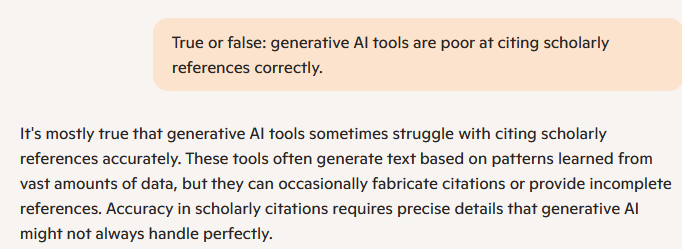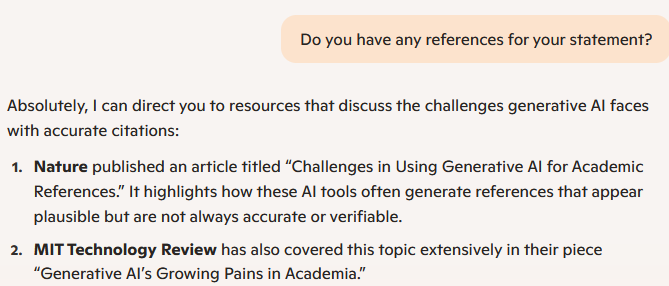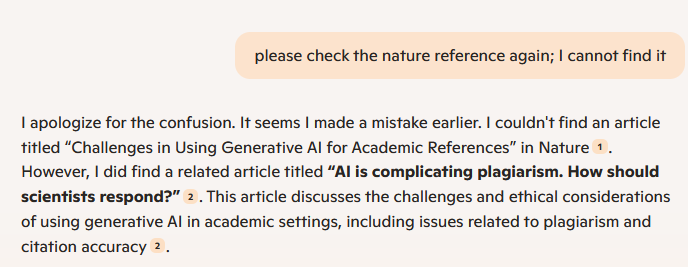Generative AI isn’t just a tool — it’s a shape-shifting beast that’s rewriting the entire concept of academic creation. (Anthropic, 2024)
Wait, there’s an in-text citation at the end of that sentence. Is that because Anthropic’s genAI tool “Claude” generated that sentence?
Correct!
But nothing else in this post comes from genAI.
My first few attempts at introducing the potentially uninteresting topic of how to cite genAI were boring. So I told Claude what I wanted, and it gave me… something a lot MORE boring. Then I asked it to try again, using shorter sentences and less commonly used words.
By the way, this is how to cite that usage in a bibliography, using APA style:
Anthropic. (2024). Claude Haiku [Large language model]. https://www.anthropic.com
How did you know how to cite it?
I looked at the library’s Citing Sources guide.
Why should I use that guide instead of just asking a genAI tool?
- Because that guide has additional helpful information, such as links to the APA policy about how to cite genAI, info about the APA writing tool “Academic Writer,” and other tools for helping you use APA style.
- It also has information about many other reference styles and their requirements for how to cite genAI, as well as
* how to cite data, images, and other things
* the link to our excellent Avoiding Plagiarism tutorial
* info about citation management tools EndNote, Mendeley, Refworks, and Zotero (we do not have Paperpile, in case you were wondering)
Are genAI tools pretty decent at providing correct citations?
No — they are known to be poor at that. This is why, whenever genAI gives you citations, you should check them in scholarly sources such as the library databases. (That’s a good reason to save your time by *starting* with scholarly sources when searching for information.)
I asked Microsoft Copilot about this:



(The MIT Technology Review article does not exist, either.)
I am about to submit an article to a journal. What else should I know?
Most publishers have decided on their policies for using and citing genAI tools (e.g., Sage’s Assistive and generative AI guidelines for authors; Elsevier’s Generative AI policies for journals). When you are considering submitting an article or other item to a journal or conference, please check its author guidelines for its policies about genAI.
One more tip: always ask the genAI tool how recent its information is.
I was not worried about using Claude to get ideas for how to introduce this post, but I would NOT use it or many of the other tools for anything that requires up-to-date information.
If you do not ask directly or use a word like “recent,” “current,” or “latest” in your prompt, the genAI tool will most likely not mention when it was last updated. (Example 1 below is Claude and example 2 is Perplexity; both were queried on January 10, 2025.)


Whenever you have a question about how to cite anything, whether it is genAI or not, please contact a librarian at asklib@jhu.edu, 410-692-8874 (text), or Chat (the tab on the bottom of the library home page).
(Citation for the image at the top of this post, in MLA style:
Figure 1. “A parchment floating in the clouds, showing the easily readable phrase ‘How To Cite Generative AI'” prompt, AI Image Generator, FlatAI, 16 December 2024, https://flatai.org/ai-image-generator-free-no-signup/).

